NEW LEGUME SPECIES HIGHLIGHTS 2022
Colin Hughes (University of Zürich, Switzerland)
The census of new legume species published in 2022 mirrors the diversity of the legume family as a whole. It includes shrubs from mid-elevation oak forests in central Mexico, two endangered rosewood trees from Madagascar, a giant rainforest tree from the Atlantic forests of Brazil, a tree that is seasonally almost submerged in flooded forests in the Amazon basin, a prostrate dwarf shrub from dry valleys of Yunnan in SW China, a woody climber from deciduous tropical forests in Laos, SE Asia, several geoxyles from the fire-prone Cerrado savannas of South America, a set of prostrate herbaceous perennials from tropical Australian grasslands and Eucalyptus woodland, a putative hybrid forming a large tree in urban Singapore, and a rare shrub from a remote area of the Blue Mountains in Australia. In other words, amongst these 2022 novelties we have a representative snapshot of the overall diversity of growth forms, biomes, and geographic ranges found across legumes as a whole. The species highlighted here provide a flavour of the new discoveries of 2022. A full list of taxonomic papers is in the 2022 Legume Bibliography at the end of this issue of the Bean Bag.
Two new Brongniartia species narrowly endemic within the Río Balsas Depression in Mexico
Of the c. 60 species of Brongniartia (Papilionoideae, Brongniartieae) all but one are distributed in Mexico. The majority of species are shrubs in seasonally dry tropical forests and mid-elevation oak and pine-oak forests. The two new species highlighted here, B. alvarezii R. Cruz-Durán, R. Bustamante & Dorado and B. variabilis Dorado, R. Cruz-Durán & R. Bustamante add to the already impressive tally of narrowly restricted endemic Brongniartias concentrated in the Río Balsas Depression, especially in the State of Guerrero in Mexico which is a hotspot for the genus. Flowers of Brongniartia species are typically coppery maroon; B. alvarezii is the second species of the genus with cream-white flowers joining the outlier species B. ulbrichiana from S. America which also has pale yellowish flowers.
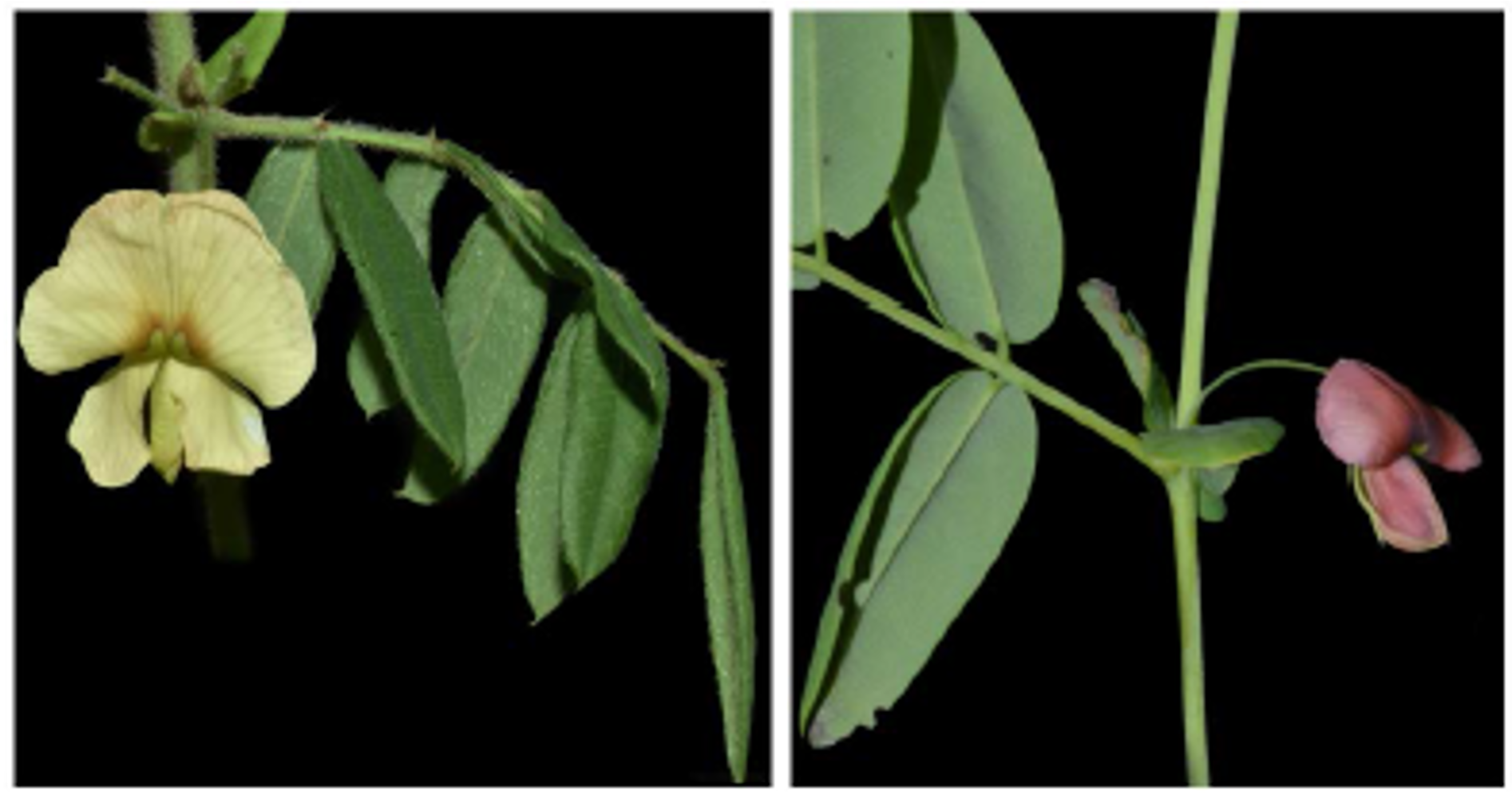 Brongniartia alvarezii and B. variabilis. Photos: Gerardo Cuevas & Óscar Dorado.
Brongniartia alvarezii and B. variabilis. Photos: Gerardo Cuevas & Óscar Dorado.
Dorado Ó, Cruz-Durán R, García RB (2022) Two new closely related species of Brongniartia (Fabaceae, Faboideae) from the Sierra Madre del Sur in Guerrero, México. Phytotaxa 544(1): 1-10. https://doi.org/10.11646/phytotaxa.544.1.1
Two new Endangered species of Dalbergia from Madagascar
Given the international interest and high level of conservation concern surrounding many species of the genus Dalbergia (Papilionoideae, Dalbergieae), it is more important than ever that the diversity of species in the genus is well documented. In other words, we need to know how many species there are, where they grow and what their conservation status is, based on rigorous taxonomic evidence, in order to develop plans for their sustainable management. This is because many Dalbergia species form durable and beautifully coloured heartwood, so-called rosewoods, which are highly valued for making musical instruments and furniture. Demand for these precious woods means that several species have been subjected to intense, unsustainable, and often illegal logging. As a result, almost all species of Dalbergia are listed in the Convention on International Trade in Endangered Species of Wild Fauna and Flora (CITES).
The genus Dalbergia comprises c. 270 species and occupies a pantropical distribution. At least 48 species occur in Madagascar, all but one of them endemic, representing an exceptional hotspot of diversity within the genus. This flock of Madagascan species is the focus of intensive new phylogenomic and population genomic analyses based on more than 600 accessions of Malagasy Dalbergia including all the Madagascan species and representing their intraspecific diversity, carried out by Simon Crameri during his PhD at the University of Zurich in collaboration with the Madagascar Precious Woods Project at Missouri Botanical Garden (https://discoverandshare.org/2022/02/10/protecting-precious-woods-in-madagascar/). This prodigious field sampling and DNA sequencing is revealing that a subset of Madagascan species are polyphyletic, prompting description of additional species, including Dalbergia pseudomaritima Crameri, Phillipson & N. Wilding and D. razakamalala Crameri, Phillipson & N. Wilding, from eastern Madagascar, both of which are categorized as Endangered. It seems that the number of Madagascan Dalbergia species has been substantially under-estimated and that more new species are in the pipeline.
 Left to right, Dalbergia razakamalala habit and flowers, D. pseudomaritima flowers and fruits. Photos: Charles Rakotovao and Sandratra Aina Fanantenana Andrianarivelo, Missouri Botanical Garden Madagascar Program.
Left to right, Dalbergia razakamalala habit and flowers, D. pseudomaritima flowers and fruits. Photos: Charles Rakotovao and Sandratra Aina Fanantenana Andrianarivelo, Missouri Botanical Garden Madagascar Program.
Crameri S, Phillipson PB, Rakotonirina N, Wilding N, Andriamiarisoa RL, Lowry PP, Widmer A (2022) Taxonomic studies on Malagasy Dalbergia (Fabaceae). III. Two new species from southeastern Madagascar and an emended description of the rosewood species Dalbergia maritima. Systematic Botany 47(2): 397-416. https://doi.org/10.1600/036364422X16512564801614
A new giant tree species of Dipteryx from the Brazilian Atlantic forest
The newly described Dipteryx hermetopascoaliana C.S. Carvalho, H.C. Lima & D.B.O.S. Cardoso (Papilionoideae, Dipterygeae) is a large canopy tree reaching 30m in height and > 100cm in trunk diameter. Material of this species was first collected by Ducke in 1949, but that material and subsequent collections were identified as D. odorata until this study using more detailed morphological and phylogenetic evidence clearly showed it to represent a distinct species. One might imagine that large tree species would be easily discovered, but this is the second giant canopy emergent legume tree species described from the Atlantic rain forests of Brazil in the last five years following the description of Dinizia juerana-facao G.P. Lewis & G.S. Siqueira in 2017. As pointed out by Carvalho et al. (2022), very often these rain forest giants remain poorly known because they are rare, and infrequently and often incompletely collected. They stand as a stark reminder of how incomplete our knowledge of these hyper-diverse Mata-Atlântica forests remains. Like many Atlantic rain forest trees, D. hermetopascoaliana is apparently a rare endemic. Recent surveys have located the species in just one small forest fragment surrounded by a cattle farm and a sugar cane plantation. As pointed out by Carvalho et al. (2022), the continued rapid pace of species discovery in the Atlantic rain forests of Brazil, alongside the fact that some of these new species are giant trees, suggests there are many legume and other plant species still to discover and document, even as these forests disappear.
 From left to right, stem of Dipteryx hermetopascoaliana with Catarina de Carvalho, the first author of the new species; leaves of D. hermetopascoaliana; tree trunk with Domingos Cardoso, Catarina de Carvalho, José Barbosa “Baixinho”, and Haroldo de Lima, authors of this new species; the small forest fragment in Alagoas State, NE Brazil which harbours the only population of D. hermetopascoaliana located in recent surveys. Photos courtesy of Domingos Cardoso and Débora Zuanny.
From left to right, stem of Dipteryx hermetopascoaliana with Catarina de Carvalho, the first author of the new species; leaves of D. hermetopascoaliana; tree trunk with Domingos Cardoso, Catarina de Carvalho, José Barbosa “Baixinho”, and Haroldo de Lima, authors of this new species; the small forest fragment in Alagoas State, NE Brazil which harbours the only population of D. hermetopascoaliana located in recent surveys. Photos courtesy of Domingos Cardoso and Débora Zuanny.
Carvalho CS, Lima HC, Zuanny DC, Gregório BS, Cardoso DB (2022) The discovery of a new giant legume tree species in a severely fragmented landscape underscores the alarming threats to the biodiversity of the Brazilian Atlantic Forest. Botanical Journal of the Linnean Society. 8 Oct 2022. https://doi.org/10.1093/botlinnean/boac034
Legume collecting by canoe: A new species of Hydrochorea from the Amazon
With only the tree canopy projecting above the waterline in the flooded forests of the Río Negro, deep in the rain forests of the Amazon, the only way to collect and photograph the new ingoid legume, Hydrochorea uaupensis M.P. Morim, Iganci & E.J.M. Koenen, was by boat. This new species is known so far from just two collections from the Upper Río Negro region in the Brazilian Amazon (Amazonas state), in seasonally inundated, open vegetation, known in Brazil as “campinarana” on white sand. This new species is described as part of a revision by Soares et al. (2022) of the recircumscribed genus Hydrochorea (Caesalpinioideae, mimosoid clade), incorporating the genus Balizia and two species of west African trees formerly placed in the genus Albizia. Under this new circumscription of Hydrochorea the ten recognized species form a robustly supported amphi-Atlantic clade of mainly water-dispersed species of seasonally flooded riverine and coastal rain forests.
 Hydrochorea uaupensis, in flooded white sand campinarana vegetation with just the tree crown emerging above the water. Photos: Erik Koenen and João Iganci.
Hydrochorea uaupensis, in flooded white sand campinarana vegetation with just the tree crown emerging above the water. Photos: Erik Koenen and João Iganci.
Soares MVB, Koenen EJM, Iganci JRV & Morim MP (2022) A new generic circumscription of Hydrochorea (Leguminosae, Caesalpinioideae, mimosoid clade) with an amphi-Atlantic distribution. PhytoKeys 205: 401-437. https://doi.org/10.3897/phytokeys.205.82775
A new Indigofera endemic to Yunnan, SW China
The genus Indigofera (Papilionoideae, Indigoferae) is the third largest genus of legumes after Astragalus and Acacia and occupies a wide distribution with centres of diversity in Africa and Madagascar (c. 550 species), Asia, especially the temperate Sino-Himalayan region (ca. 105 species), Australia (c. 50 species), and the New World (c. 45 species). Of the Asian species, 79 (45 endemics) occur in China, where a steady stream of new species continues to be added, including this year, Indigofera vallicola Huan C. Wang & Jin L. Liu, a prostrate dwarf shrub known from just two localities in xerophilous scrub and grasslands in the Luzhijiang valley, central Yunnan.
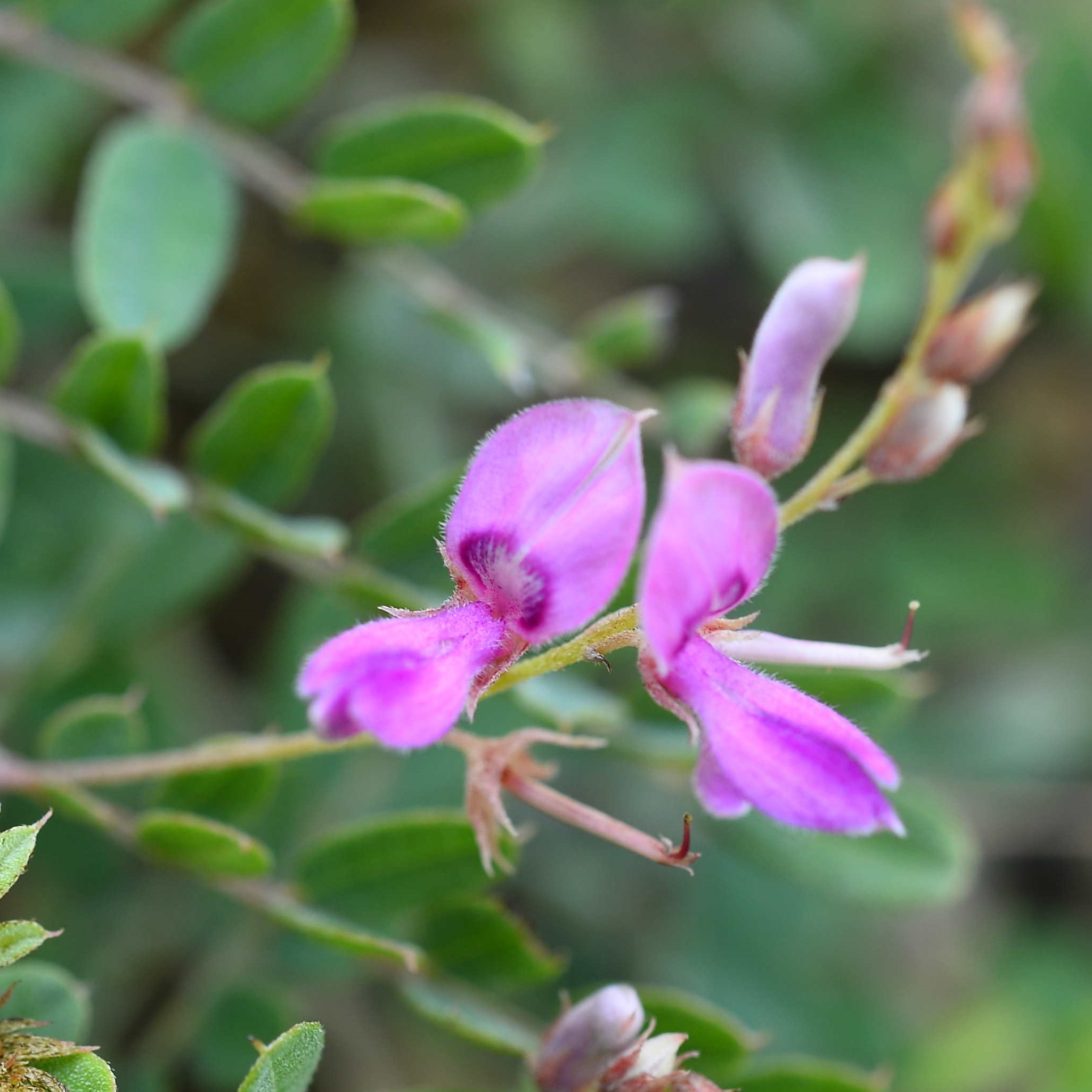 Flowers of Indigofera vallicola. Photo: Huan Chong Wang.
Flowers of Indigofera vallicola. Photo: Huan Chong Wang.
Liu JL, Li SG, Yang F, Wang HC (2022). Indigofera vallicola (Fabaceae), a new species from Yunnan, southwest China. PhytoKeys 199: 9-16. https://doi.org/10.3897/phytok-eys.199.85437
Millettia densiflora: A new woody climber from Laos
Millettia (Papilionoideae, Millettieae) comprises 50-80 species in Asia and is especially diverse, but poorly known in Thailand and the Indo-Chinese region and is under investigation by Sawai Mattapha and colleagues. During botanical expeditions to Bolikhamxai Province in Laos in 2020 and 2021 the new species Millettia densiflora Mattapha, Lanors. & Lamxay was discovered. It is a woody climber, grows in mixed deciduous and secondary forests and is currently only known from the type locality.
 Flowers, leaves and fruit of Millettia densiflora. Photos: S. Lanorsavanh
Flowers, leaves and fruit of Millettia densiflora. Photos: S. Lanorsavanh
Mattapha S, Sungkaew S, Pongamornkul W, Lanorsavanh S, Lamxay V, Hein KZ (2022) Notes on the genus Millettia (Fabaceae: Millettieae) in the Indo-Burmese region; a new species, new records and lectotypifications. Thai Forest Bulletin (Botany) 50(1): 75-87. https://doi.org/10.20531/tfb.2022.50.1.08
Mimosa: the inventory of species continues
It seems that every year, new species of Mimosa (Caesalpinioideae, mimosoid clade) are discovered and described, adding to the prodigious tally of species in this large genus of now > 600 species. This year is no exception with three new species described from the savannas of the Cerrado in Brazil, one of the diversity hotspots for the genus with c. 270 species. In common with many Cerrado Mimosas, and indeed many savanna species in general, all three of these new species are geoxyles, i.e. functionally herbaceous subshrubs with enlarged underground woody lignotubers, a life history strategy that facilitates survival by resprouting after fire. Marcelo Simon, who continues to spearhead work on Mimosa in Brazil, says that the inventory of species is still far from complete and that we can expect on-going discoveries as more remote areas are surveyed in the coming years.
 Left to right: Mimosa gustavoi T.P. Mendes, Marc.F. Simon & M.J. Silva, M. cavalcantina T.P. Mendes, Marc.F. Simon & M.J. Silva, M. venosaT.P. Mendes, Marc.F. Simon & M.J. Silva, and typical fire-prone Cerrado habitat of M. venosa, Goiás, central Brazil. Photos: left, João Bringel, the rest, Marcelo Simon.
Left to right: Mimosa gustavoi T.P. Mendes, Marc.F. Simon & M.J. Silva, M. cavalcantina T.P. Mendes, Marc.F. Simon & M.J. Silva, M. venosaT.P. Mendes, Marc.F. Simon & M.J. Silva, and typical fire-prone Cerrado habitat of M. venosa, Goiás, central Brazil. Photos: left, João Bringel, the rest, Marcelo Simon.
Mendes TP, Simon MF & da Silva MJ (2022) Three New Species of Mimosa L. (Leguminosae) from the Brazilian Cerrado Hotspot of Biodiversity. Brittonia 9 Sep. 2022: 1-20. https://doi.org/10.1007/s12228-022-09723-x
A proliferation of new species of Neptunia in Australia
Neptunia (Caesalpinioideae, mimosoid clade) is unusual among mimosoid legumes in its herbaceous perennial habit and globose to ellipsoidal inflorescences usually comprising a mixture of bisexual and neuter flowers that have yellow, petaloid staminodia. A new taxonomic revision of the Australian and Malesian species published this year includes 10 new species from tropical Australia. This brings the total number of species in the genus to 22.
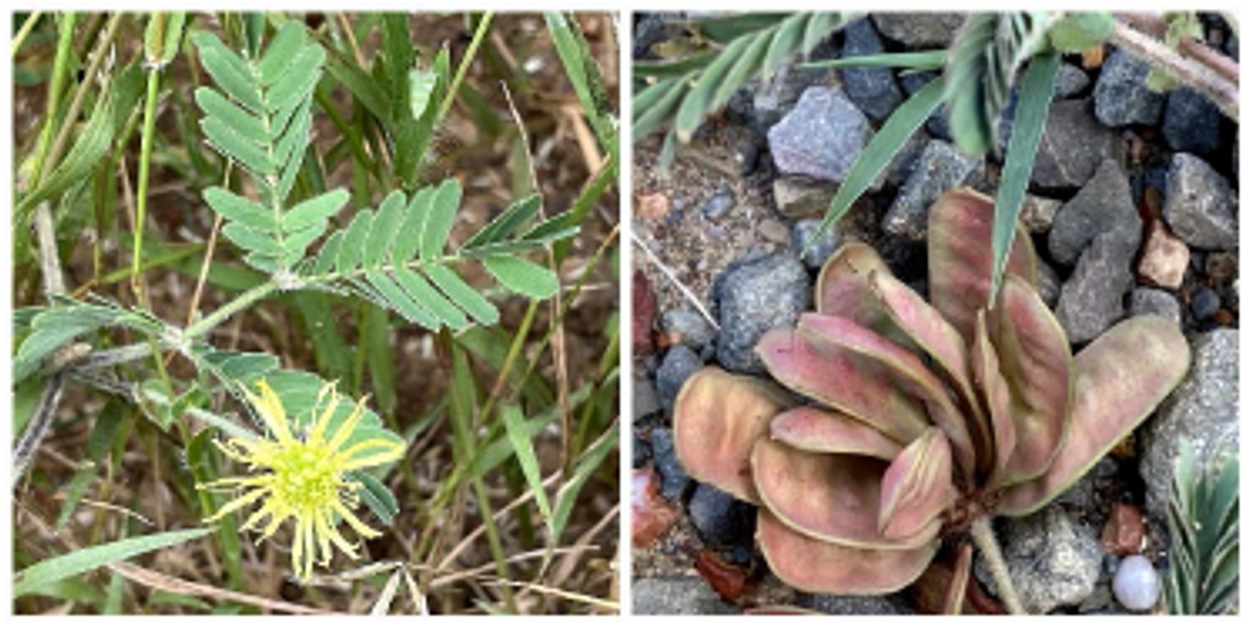 Neptunia insignis. Photos: K.R. McDonaldWang.
Neptunia insignis. Photos: K.R. McDonaldWang.
Bean AR (2022) A revision of Neptunia Lour. (Leguminosae: subfamily Caesalpinioideae, Mimosoid clade) in Australia and Malesia. Austrobaileya 12: 59-106.
Ormosia corcovada, a new tree species narrowly endemic in NW Colombia
Of the c. 130 species of Ormosia (Papilionoideae, Ormosieae), c. 21 are found in Colombia. Ormosia corcovada Herrera-Palma, C.H. Stirt. & D.B.O.S. Cardoso was found among the many un-named herbarium collections of Ormosia by Maribel Herrera-Palma as part of her Masters thesis research. This new species forms a tree to 30m, is narrowly endemic to the lower Cauca Valley, NW Colombia, and has flowers with deep inky-purple petals and bright red monochromatic seeds. The species epithet corcovada, meaning hunchback in Spanish, refers to the hunch-back shape of the one-seeded pods.
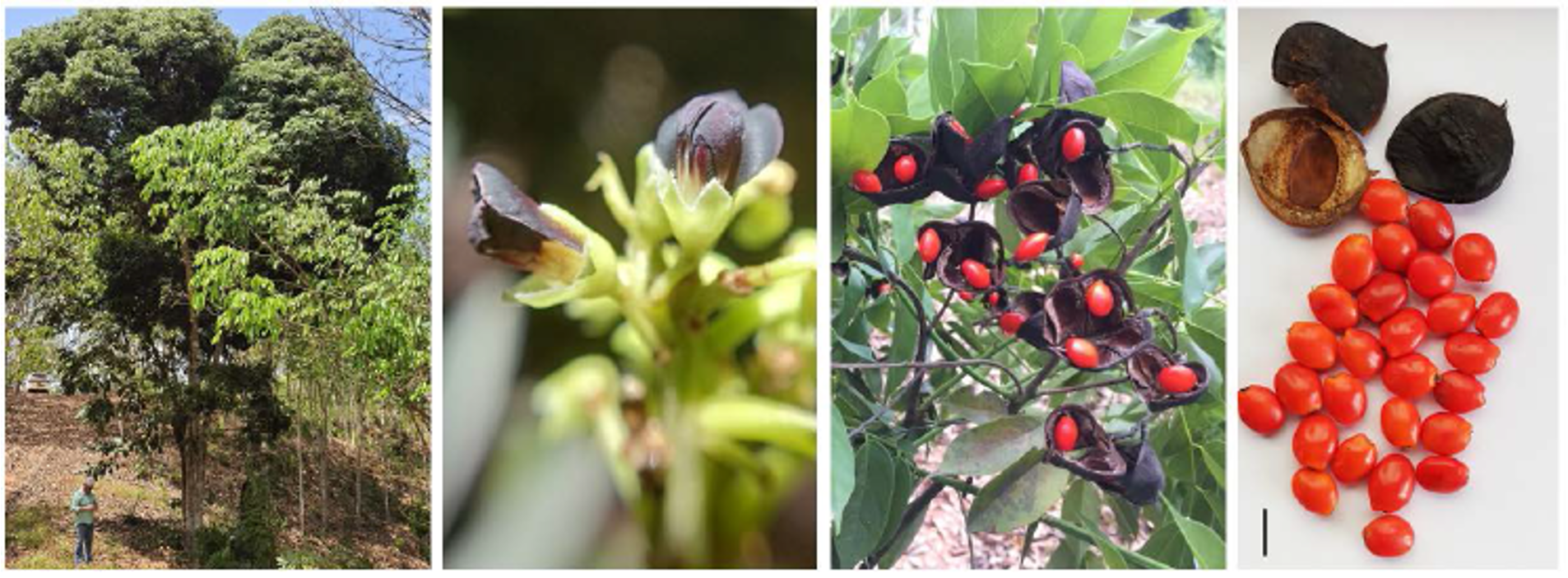 Tree habit, flowers with deep blackish violet petals, fruits and red monochromatic seeds of Ormosia corcovada. Photos: Andrés Cuadro, Maribel Herrera-Palma and Ricardo Callejas-Posada.
Tree habit, flowers with deep blackish violet petals, fruits and red monochromatic seeds of Ormosia corcovada. Photos: Andrés Cuadro, Maribel Herrera-Palma and Ricardo Callejas-Posada.
Herrera-Palma M, Stirton CH, Ruiz-Bohórquez LK, Callejas-Posada R, Cardoso DB (2022) Ormosia corcovada, a new papilionoid legume from the Bajo Cauca Region of Northeastern Colombia. Systematic Botany 47(3): 861-868. https://doi.org/10.1600/036364422X16573019348391
Beating the drum for Pultenaea percussa – described and rediscovered in 2022
Contributed by: Dr Russell Barrett, National Herbarium of New South Wales, Australia.
The bush peas, genus Pultenaea, are the largest genus in the largest legume tribe in Australia (tribe Mirbelieae, Papilionoideae). Despite being monographed just 20 years ago, new research is revealing a plethora of new species, especially rarely-collected, local endemics.
One such pea, named by Renner et al. (2022), is the Hollanders River Bush-pea, Pultenaea percussa. At the time of naming, it was known from only a single collection, made in 1970 by the amateur botanists T. & J. Whaite, in a remote part of the Blue Mountains in New South Wales, SE Australia. Searches to relocate the species prior to naming were unsuccessful. However, just a few months after the species was named, one of the authors on the paper, Steve Clarke, persisted, first by car, then by push-bike and finally on foot, to traverse suitable habitat along the remote Hollanders River, and located a single population consisting of a few hundred plants of this remarkable species.
The leaves of P. percussa are unique in the genus, short, and almost club-shaped, bright green below, but with a wedge sliced out of the top, and the face being strongly glaucous. This is a rather unusual adaptation of the typical in-rolled leaf of related species.
The species epithet is also aptly unique, representing the lived experience of the first author while writing the taxonomic account of this group of species. From the Latin percussa ‘thrust through’ or ‘pierced’, but also referencing the modern use of this root in ‘percussion’. The hollow, club-shaped leaves of this species could either strike like miniature drum sticks, or be struck. The species is dedicated to everyone who lives, or has lived, with a traumatic brain injury, and especially to everyone who supports them.
Rediscovery of this rare species has enabled it to be introduced to cultivation at the Australian Botanic Garden, Mount Annan, home of the new National Herbarium of New South Wales.
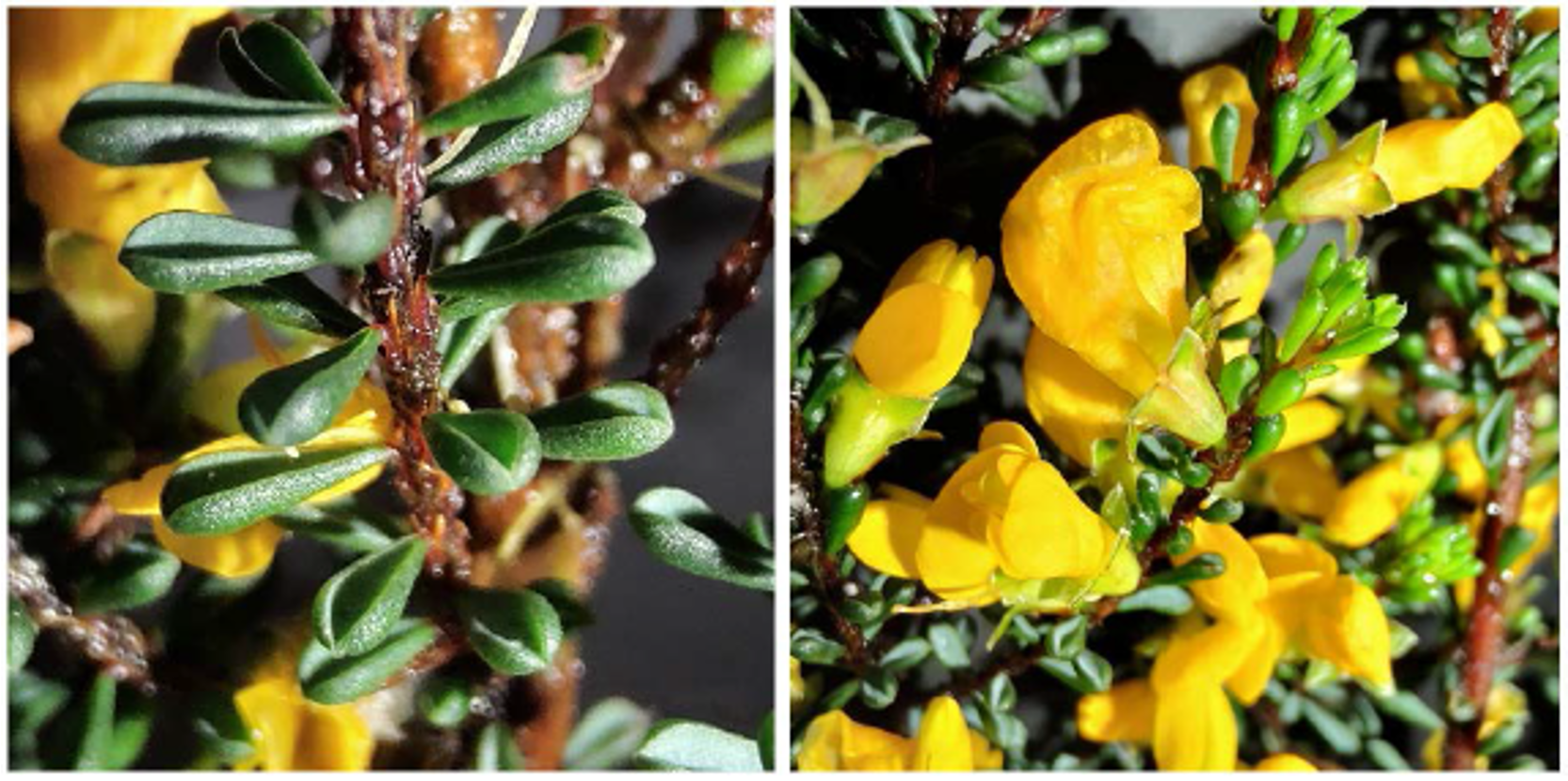 Leaves and flowers of Pultenaea percussa. Photos: Russell Barrett.
Leaves and flowers of Pultenaea percussa. Photos: Russell Barrett.
Renner MAM, Barrett RL, Clarke S, Clugston JAR, Wilson TC, Weston PH (2022) Morphological and molecular evidence refute a broad circumscription for Pultenaea glabra (Fabaceae: Mirbelieae), with implications for taxonomy, biogeography, and conservation. Australian Systematic Botany 35(3): 225–277. https://doi.org/10.1071/SB21030
A hybrid of Sindora from Singapore
Combining genetic, morphological, geographic and historical evidence, Choo et al. (2022) document and name a putative interspecific hybrid in the genus Sindora (Detarioideae). Very often interspecific hybrids result from human disturbance and that could well be the case for Sindora × changiensis L.M. Choo, Loo, W.F. Ang & Er which is restricted to urban areas in Singapore. However, historical evidence from aerial photographs shows that the hybrid individual, which is a large tree, is probably part of a remnant of natural forest, and radiocarbon dating suggests it could well be more than 200 years old.
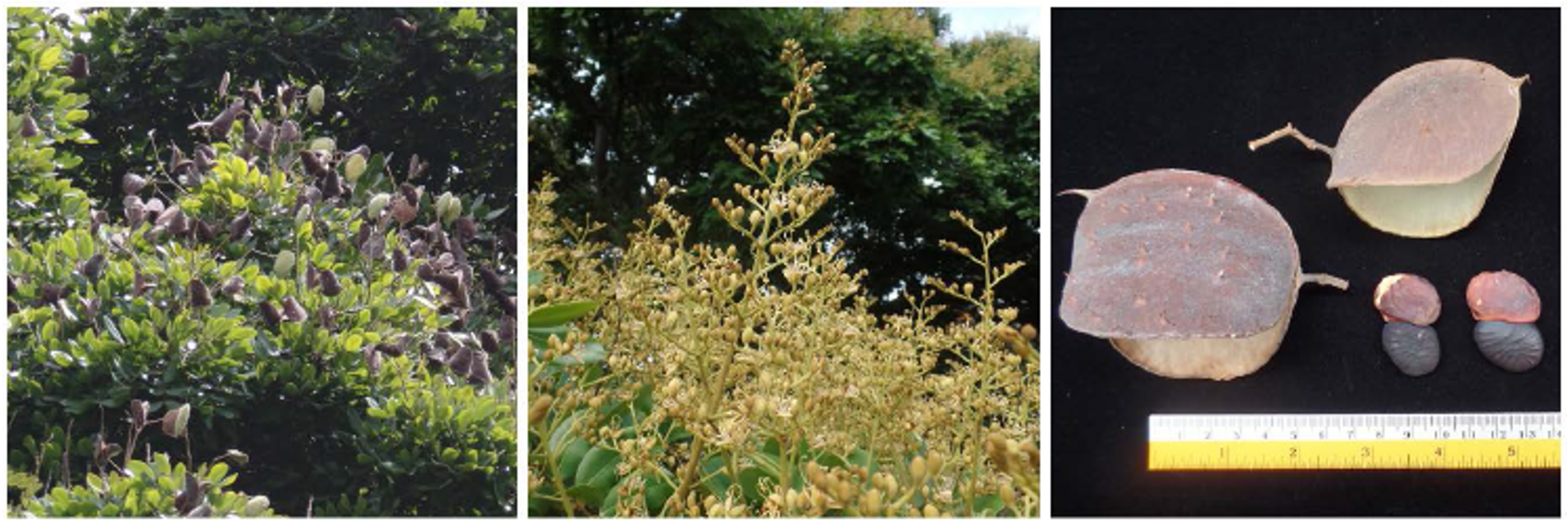 Fruits and flowers of Sindora × changiensis. Photos: Le Min Choo.
Fruits and flowers of Sindora × changiensis. Photos: Le Min Choo.
Choo LM, Loo AHB, Ang WF, Er KBH (2022) A natural hybrid of Sindora (Fabaceae, Detarioideae) from Singapore. Phyto-Keys 190: 87. https://doi.org/10.3897/phytokeys.190.79185
A 30% increment in species of the mimosoid genus Stryphnodendron
There are 28 species in the recircumscribed Stryphnodendron (Caesalpinioideae, mimosoid clade) sensu Lima et al. (2022), nine of which were described as new by Scalon et al. (2022), representing a major increment for the genus. These new species are small to large trees in Amazonian wet forests, savannas (cerrado) and Atlantic rain forests of South America, mainly in Brazil. Several of these new species are globally rare with highly restricted endemic ranges in areas where habitats are being lost, and as a result are categorized as Endangered by Scalon et al (2022).
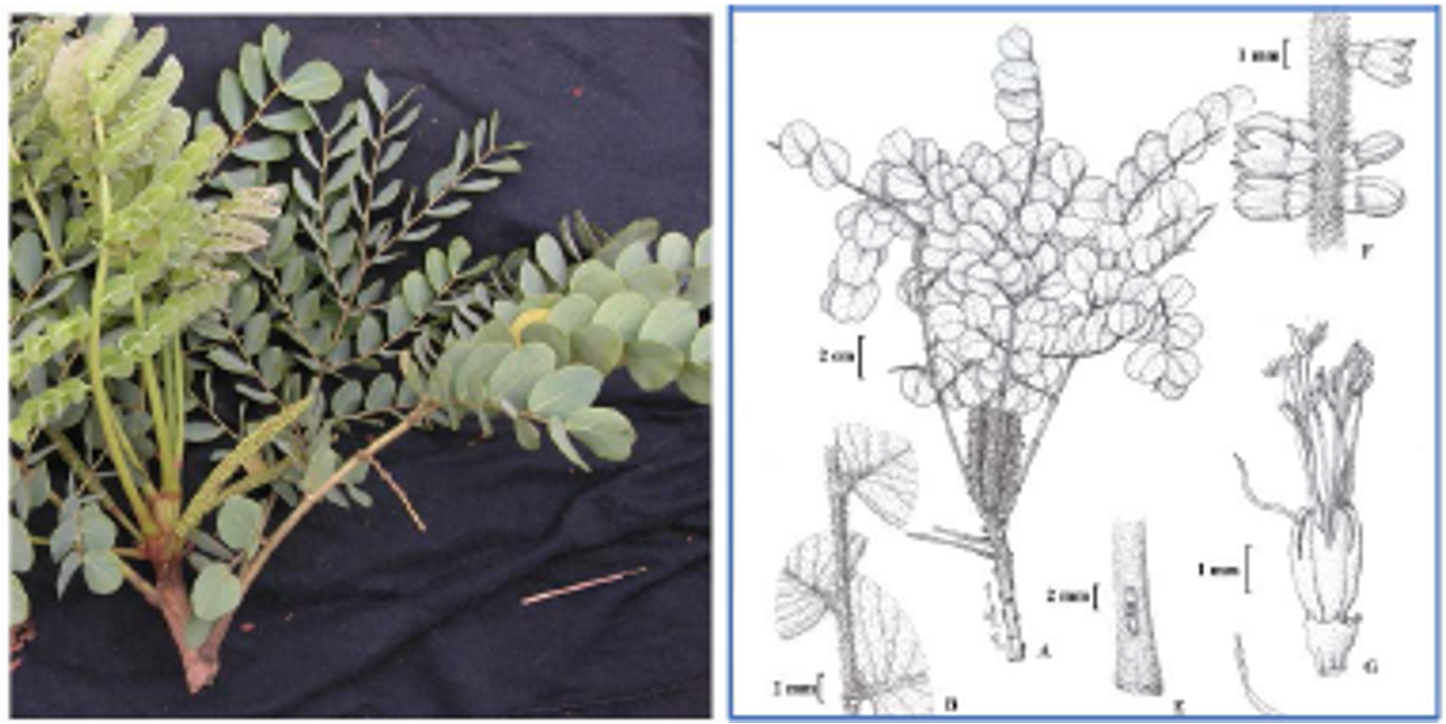 Stryphnodendron velutinum Scalon. Photo: Viviane Scalon; drawing: Maria Alice de Rezende
Stryphnodendron velutinum Scalon. Photo: Viviane Scalon; drawing: Maria Alice de Rezende
Scalon VR, De Paula-Souza J, De Lima AG, Souza VC (2022) A synopsis of the genus Stryphnodendron (Fabaceae, Caesalpinioideae, mimosoid clade). Phytotaxa 544(3): 227-279. https://doi.org/10.11646/phytotaxa.544.3.1